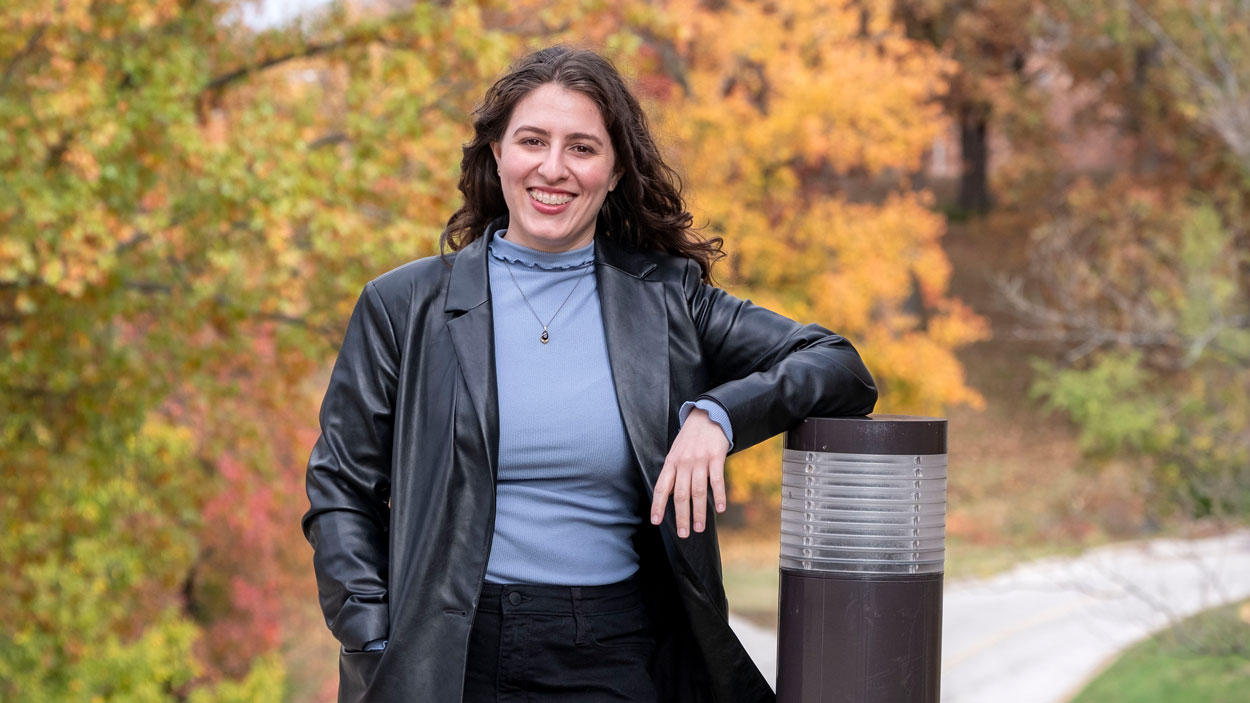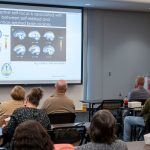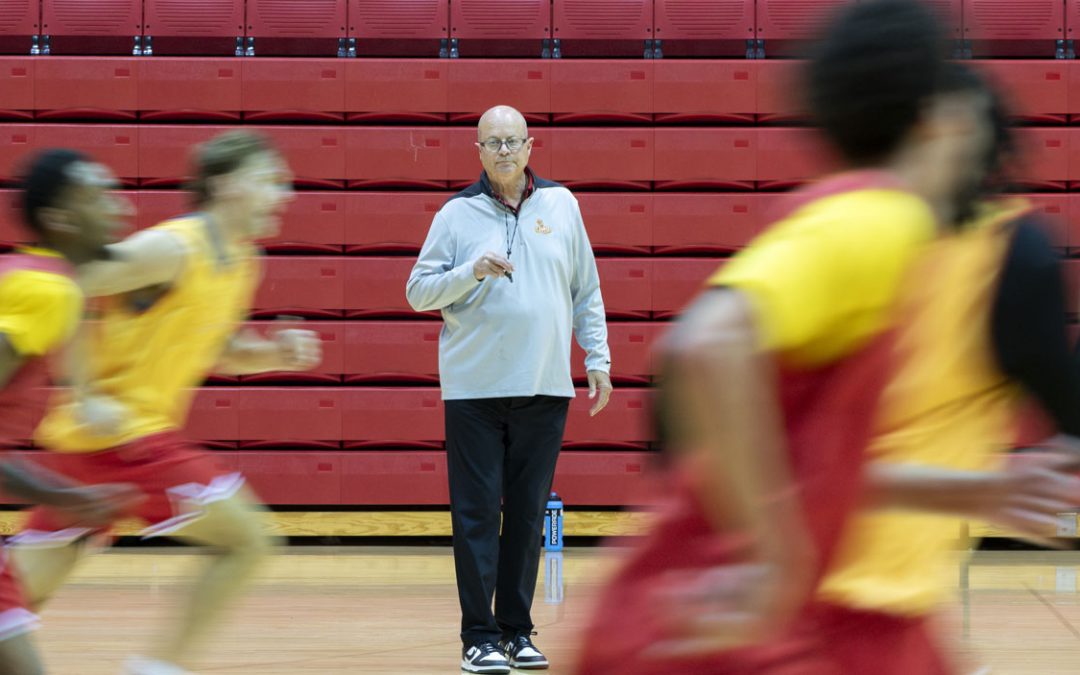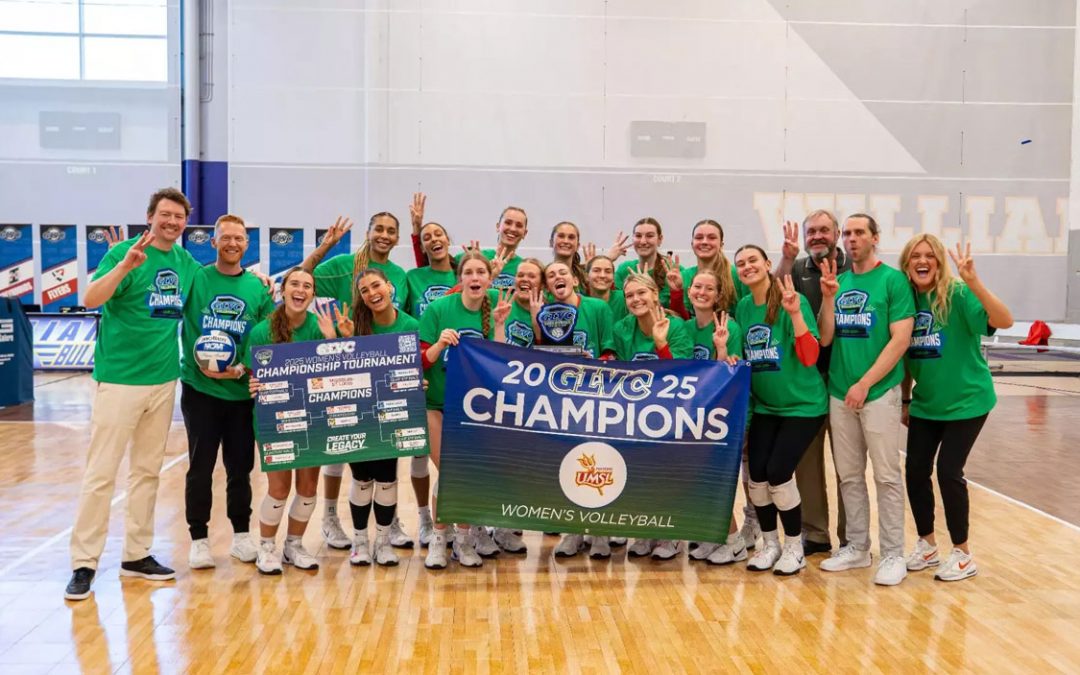
Victoria Inzana’s doctoral research has explored the impact of prison arts programs on identity and how that can contribute to rehabilitation. Inzana is on track to defend her dissertation and graduate in the spring, and she recently accepted a tenure-track faculty position at Sam Houston State University beginning next fall. (Photo by Derik Holtmann)
Victoria Inzana started reading up about prison arts programs several years ago after meeting a representative from one at a talk hosted by Department of English at the University of Missouri– St. Louis.
“The person involved in the program told me a lot about how it was changing people’s lives and identities, how they weren’t the people that they were when they were first incarcerated,” said Inzana, a doctoral candidate in UMSL’s Department of Criminology and Criminal Justice. “My interest got piqued.”
The first thing Inzana realized as she started her research was how many of these programs exist.
Rehabilitation Through the Arts, a program facilitated by the State University of New York, has gotten attention recently in the 2023 drama “Sing Sing.” Arizona State University organizes a program called {Ink}arcerated: Creativity Within Confinement, in which incarcerated individuals paint portraits shown in exhibits and put up for auction. The University of Denver runs a Prison Arts Initiative that involves incarcerated people in theater performances, dance workshops, art exhibitions and film screenings.
The Justice Arts Coalition has identified 48 states with arts-based workshops, projects or courses offered in prisons, jails, youth detention centers and other facilities involved in the criminal justice system.
“There wouldn’t be so many of these arts programs if people didn’t believe that something was happening in the program, and individuals who participated in the program wouldn’t be so passionate about engaging in a program if something wasn’t happening,” Inzana said. “You can see they have testimonials on each of their websites.”
Inzana ultimately decided she needed to investigate further. She’s made it the center of her dissertation research, focusing on a theater program in a men’s prison and using ethnographic observations with incarcerated individuals to explore how taking on roles and expressing themselves in the context of the program could influence a bigger identity shift taking place within each of them as part of a process of rehabilitation.
Planting the seeds
Inzana had already been involved in studying the prison system as a research assistant since enrolling at UMSL in 2019.
But her interest in criminology and corrections can be traced back even further, to her time as a student at Nature Coast Technical High School in Spring Hill, Florida, about 50 miles north of Tampa. She was part of a criminal justice cluster program at the school and had a chance to explore different areas of the criminal justice system, from policing to courts to corrections.
Inzana remembers a field trip she and her classmates made to a local jail.
“I remember seeing individuals who were housed there,” she said. “For me, the biggest impact was the glass that separated us. It reinforced this notion that people who are housed in these facilities are supposed to be dangerous. I think a lot of students at the time were thankful for that glass, but for me, it was the glass that prevented me from asking people questions about their experiences and how they ended up there.”
Inzana also made note of the uniforms people had to wear and the lack of individuality the system created.
Those things stuck with her as she made her way to Florida State University, where she became the first member of her family to earn a bachelor’s degree. She majored in criminology and English literature, and she got involved in undergraduate research, working with then-faculty member Jillian Turanovic, who studies topics such as the causes and consequences of victimization, violence and incarceration. She also secured an internship with the Innocence Project of Florida.
It was Turanovic who encouraged her to look into graduate school. At the suggestion of former faculty member Matt Vogel, she wound up applying to UMSL, where she clicked with then-Assistant Professor Rachel Ellis during a two-day information session for prospective students.
“We talked a lot about her work and my interest in literature,” Inzana said. “Her work is on religion and incarceration, and we had this very great conversation about how the Bible is a religious text but is also as a collection of stories, a piece of literature. I really felt like in that and in many other conversations that I had with faculty at UMSL that I was being asked to engage in deep thought, critical thinking, and I was really encouraged to ask questions and engage in social inquiry.”
That was true of faculty members such as Ellis and Beth Huebner, with whom she worked as a research assistant, and also with members of her dissertation committee – chair Marisa Omori, the director of UMSL’s PhD program in criminology and criminal justice; Associate Professor Adam Boessen and Assistant Professor Katie Quinn.
“They have been instrumental in a variety of ways including providing critical and necessary feedback on the project,” Inzana said. “Marisa has been a phenomenal chair. She is incredibly supportive, responsive and has consistently helped me think through my project.”
A tension in the system
During her doctoral studies, Inzana worked with Ellis to investigate women’s reentry from prison in St. Louis and assisted Huebner on the Prison Research and Innovation Initiative, funded by the Urban Institute and Arnold Ventures.
As part of her work on the Prison Research and Innovation Initiative, she also collaborated with former University of Missouri–Kansas City faculty member Janet Garcia-Hallett and others using qualitative data to consider the use and impact of closed-circuit cameras (CCTV) in prison. Inzana was the lead author on a recent publication about their findings in the Journal of Contemporary Criminal Justice.
From her studies and research experiences, Inzana has come to recognize the often contradictory goals that prisons and other correctional facilities have in American society. They are, first and foremost, a means of incapacitating perpetrators of crime, locking them up and removing them from the community, and they provide victims and community members a feeling of retribution as well as restitution for the damage done. They are also meant to help deter others, frightening them so that they avoid the same fate as those incarcerated.
But as they perform those functions, prisons and other detention centers are also intended to rehabilitate the individuals sentenced to serve time, helping spark behavioral changes so that they turn their lives around.
“Some of these goals clash,” Inzana said. “They’re not necessarily designed to do the same thing. A policy or practice which supports punishment may not necessarily support rehabilitation. Asking the institution to do two perhaps conflicting things – it’s hard.”
There’s evidence that correctional facilities often fall short when it comes to rehabilitation. A 2021 report from the Bureau of Justice Statistics showed that 62% of individuals released from state prisons across 34 states in 2012 were arrested again within three years and 71% were arrested again within five years. Nearly 46% of those released from prison in 2012 across the 21 states with data on persons returned to prison had a parole violation or a new sentence within five years that led them to be reincarcerated.
The role of identity
An individual’s identity has often been cited in behavioral shifts away from crime. Identity isn’t limited to demographic factors such as race, gender or socioeconomic status. Criminological research has also shown the importance of social roles – for example, marriage, parenthood, military service. Inzana’s research has focused on how social roles shape identities and can motivate shifts away from criminal behavior.
“These are social positions often attached to social institutions – things like family, employment and schools,” Inzana said. “Social roles provide individuals with the opportunity to adopt, reinforce and engage in identity. ‘I am a student because I go to school.’”
Identity is something that can be stripped away in prison as inmates are made to dress alike, follow the same routines and lack the freedom to make many of their own choices. It can be difficult, even when they’re released, to rebuild their identity outside of being a criminal.
Through her doctoral research, Inzana has been studying how participation in the theater program has helped incarcerated people start to restore that sense of identity, educating them on new topics and giving them space to express themselves creatively. It also can help them reflect upon their own lived experiences.
In the process, they might also change how they see themselves and how others view them.
“The way that community members engage with art provides that opportunity for reintegrative shaming – for people to say these are OK people, these people are good people, but what they did was bad,” Inzana said.
Inzana believes the things she’s learning from her research can influence societal views on in-prison programming and prison culture.
“Victoria has been able to draw from her background in the humanities and interests in the arts and pull together a project that is really creative and interdisciplinary,” Omori said. “She draws from a classic piece” – sociologist Erving Goffman’s “Life as Theatre with Social Life as a Performance” – “that uses the metaphor of a stage and performance for identity formation and examines these themes through observing an actual theater production.
“Victoria also really drove the project, including developing the relationships to gain access, designing the research question and study, and then successfully executing it.”
She won support along the way. Last fall, Inzana received an Association of Doctoral Programs in Criminology and Criminal Justice Student Research Award. In April, she was named a 2024 recipient of a National Science Foundation Law and Science Dissertation grant. This semester, the Department of Criminology and Criminal Justice also presented her with the Charles G. Huber, Jr. Endowed Dissertation Fellowship.
This fall, she presented her work on CCTV cameras in prison at the American Society of Criminology Annual Meeting in San Francisco. She will present her dissertation work at the Academy of Criminal Justice Sciences Annual Meeting in March in Denver.
Inspiring future students
Inzana is still writing her dissertation, but she expects to have it completed and ready to defend this spring. She’s planning on participating in commencement in May.
“I hope to continue my research agenda, examining the tensions between punishment and rehabilitation across carceral contexts and how those tensions shape access to identities,” she said of her plans for after graduation.
She has recently accepted a tenure-track assistant professor position at Sam Houston State University in the Department of Criminal Justice and Criminology, which she will start in fall 2025.
“I want to guide future students like I had the opportunity,” Inzana said. “I’m here because of all my mentors, and so I really want to have that opportunity to give back to future students, guide future scholars, make a difference in the field and in social policy. Those are all things I really want to do.”














